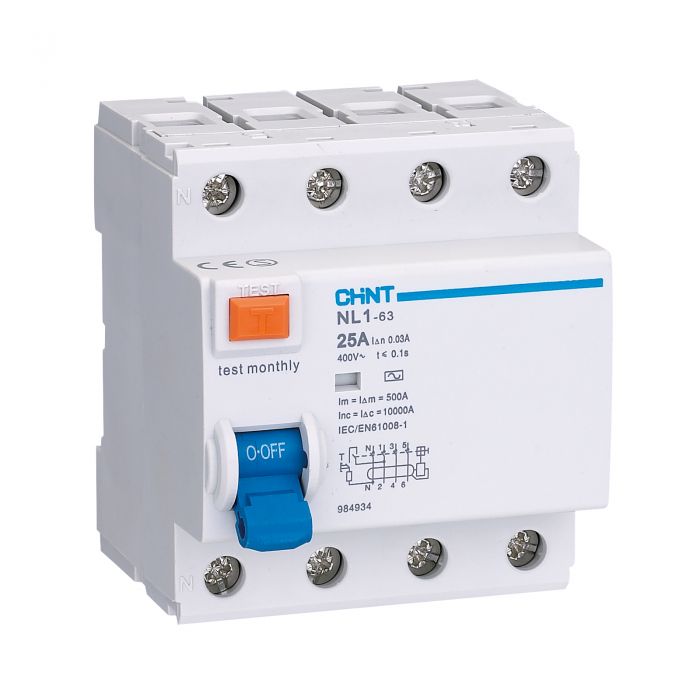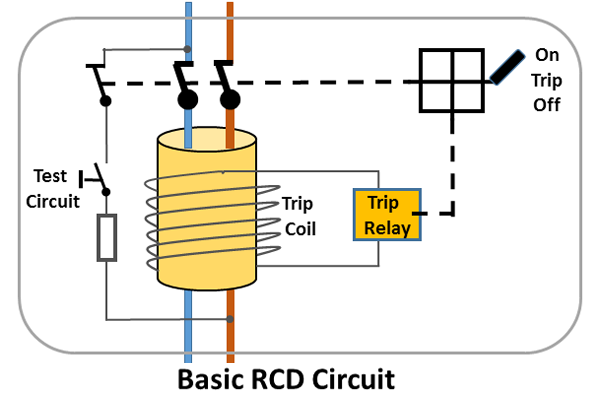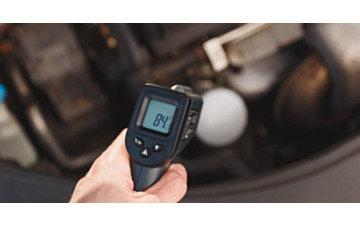Understanding Residual Current Devices (RCDs) - What do they do, how do they do it?

An RCD, or residual current device, is a safety device designed to protect against the risk of fatal electric shocks. RCDs offer an even more reliable level of personal protection that ordinary fuses and circuit breakers can’t provide. They can also provide a notable level of protection against the risk of electric fires.
They use a simple but reliable mechanism to quickly break electrical circuits, preventing the user from suffering any serious harm as a result of an electrical shock. This way, they’ve saved countless lives throughout the years.

What do RCDs do?
A Residual Current Device constantly monitors the current going through any circuit, and cuts it off automatically if it detects a potentially dangerous fault. It’s a highly sensitive device that’s capable of reacting in milliseconds, enabling it to provide reliable protection for assets, machinery, and crucially, human life.
When understanding what an RCD does, it helps to envision a simple electrical circuit. Electricity flows through live cables and, then, through an appliance where it gives power to a particular function. For example, a switched-on kettle will begin to heat water up. The electricity will then flow back through the neutral cable to complete the full electrical circuit. RCDs are designed to check that the current flowing through the live wire is equal to the current flowing back through the second part of the circuit, aka the neutral wire. If, for any reason, some of the electricity flowing into that kettle was to flow out through the earth cable, the residual current flowing through the neutral cable would be less than the current flowing through the live cable.How do RCDs work? (The simple version)
The main job of an RCD is to ensure that there’s a consistent balance between the current flowing through the live wire of a circuit, and the current flowing through the neutral wire. If an imbalance occurs for whatever reason, that’s where the potential arises for dangerous electric shocks, which is when the RCD reacts to cut the circuit. When understanding what an RCD does, it helps to envision a simple electrical circuit. Let’s say, for example, a kettle boiling. In its simplest terms, electricity flows from the mains supply through the live cables, giving the kettle sufficient power to heat water up. The electricity will then flow back through the neutral cable to complete the full electrical circuit. The electricity will then flow back through the neutral cable to complete the full electrical circuit.
The RCD is designed to check that the current flowing through the live wire is equal to the current flowing back through the second part of the circuit, aka the neutral wire. If some of the electricity flowing into that kettle was to flow out through the earth cable (for any reason), the residual current flowing through the neutral cable would be less than the current flowing through the live cable. If the current is not the same, the RCD will simply disconnect the supply.
How do RCDs work? (The in-depth version)
Essentially, inside every RCD is an iron core. The electricity that flows into the RCD from the live cables passes through a switchgear and a coil that goes around that iron core. When this electricity passes around the coil, it generates a magnetic field. The current that flows back into the RCD (from the neutral cables) passes around a coil that is wired the opposite way around to that of the live wire. This produces two opposing magnetic fields.
The current returning through the neutral wire should be the same as the current that was supplied, and therefore, the two opposing magnetic fields should be equal, and cancel each other out. With no magnetic field overall, nothing will happen to the switchgear. The current will continue to run around the appliance as intended.
If there is a fault in an appliance, some electricity can leak away to ground. In these circumstances, the current supplying the device would still be the same, so the magnetic field in the first coil would still be the same too. However, less current would return to neutral coil as some is leaking away. This means there would be an imbalance between the two magnetic fields.
So, that leaves a net magnetic field which triggers the switchgear. How? The switchgear possesses an iron panel which is attracted to the iron core in the event of a net magnetic field. This breaks the circuit. A reset button is then pressed to push the circuit back into place.
What are the different types of RCD
There are a couple of different kinds of RCD that you’ll either find, purchase or install yourself. There are ‘plug in’ types that act as a safety adapter for appliances that do not have a circuit breaker in built, and there are other options that sit on fuse boards or boxes.
Historically, BS7671 recognised two types of earth-leakage circuit breakers. As well as what we understand to be an RCD today, there used to also be an older voltage-operated device. Nowadays we only deal with current-operated devices.
Residual current can take various waveforms depending on the load characteristics, so today there are a variety of RCD types to ensure appliances are equipped to deal with any issues. Electric Installation Wiki indicates that “the following types of RCDs are defined in IEC 60755, for suitable protection of different forms of residual current”:
Type AC
Type AC RCDs are there to detect alternating currents. They’re suitable for general use and cover the vast majority of applications.Type A
Type A RCDs also residual current as well as alternating. Type A RCs are specifically intended to be used for single phase class 1 electronic loads.Type F
In addition to the detection characteristics of type A RCDs,type F RCDs are specially designed for circuit protection where single phase variable speed drivers could be used.Type B
Type B RCD are intended to be used for loads with three-phase rectifiers, such as variable speed drives, PV system, EV charging station and medical equipment. You may also come across the following phrasing with regards to RCDs:Fixed RCDs
These are installed inside a consumer unit, or fusebox. They are installed to provide protection to both the individual who will be interacting with the unit, and the group of circuits that are involved. Fixed RCDs provide a high level of protection as they protect the wiring and the sockets on a circuit.Socket-Outlet RCDs
Specially designed socket-outlets with an RCD inbuilt, used in place of a standard socket to provide protection to the person in contact with any equipment used.Portable RCDs
Finally, portable RCDs are designed to plug into pretty much any standard socket-outlet. Appliances are then plugged into the portable RCD. They provide protection on demand.
How to test RCDs?
To make sure that you have fitted RCDs into your property or circuit board correctly, you’ll always need to make sure they’re being tested at regular intervals. The good news is that RCDs are easily testable and re-settable devices.
Each RCD will be fitted with a test button, which creates a safe, small leakage. It will be fitted with a reset button, which reconnects the conductors once a fault has been cleared.
Testing an RCD: Step by Step Guide
- Plug a small lamp appliance into a socket and make sure it is working. Leave it turned on.
- Ensure that the electricity is connected to the RCD securely, and that the main switch is in ‘on.’
- Turn off all of your other electronic appliances such as televisions and radios.
- Press the test button on your RCD, but do not hold your finger down on the test button. At this point, your RCD should operate (i.e. turn off the appliance). If it doesn’t function at this stage, you’ll need to have it checked out by a professional.
- After pressing the test button, and the RCDs have turned off, check that your small lamp is now off. You’ll need to move the lamp around several power points, and ensure that it does not turn on when plugged into any of them.
- Once you’ve completed your testing, you can turn your RCD back on and check that the lamp works when plugged back into a power point.
It’s worth noting that double pole RCDs disconnect both the energised conductors and return conductors when a fault occurs, but single pole RCDs only disconnects the energised conductor.
Nuisance tripping
If you find that your RCDs are occasionally tripping with no clear reason why, it may be because of the age of your appliances. Ageing electrical appliances with old wiring may have a small amount of earth leakage, and while this is normal, this current imbalance can trip an RCD. It is also worth remembering that earth leakage increases with each additional electrical appliance you have plugged in. A single meter box RCD protecting all household wiring is more likely to experience nuisance tripping as a result.
If you have fixed RCD protection, it will reduce the risk of electric shock to you and the people who use your equipment. LED Controls supplies a range of different electrical circuit protection methods including Miniature Circuit Breakers (MCB), Moulded Case Circuit Breakers (MCCB), Residual Current Devices (RCD) and Residual Current Breakers with Overload protection (RCBO).
We are a trusted UK distributor from a number of leading brands including ABB, Chint and IMO. Shop our range of electrical circuit protection here, but remember, although RCD protection reduces the risk of injury from electric shocks - it does not reduce the need to take care. If you have any questions or queries about LED Controls’ services and products, don’t hesitate to get in touch with the team by emailing sales@ledcontrols.co.uk, calling 08450 756230, or clicking here to fill in a contact form.









































